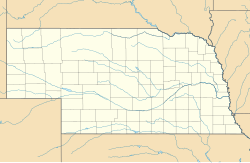Grace Protestant Episcopal Church | |
 The church in 2010 | |
| Location | 546 North Cedar Street, Red Cloud, Nebraska |
|---|---|
| Coordinates | 40°05′26″N98°31′12″W / 40.09056°N 98.52000°W |
| Area | less than one acre |
| Built | 1891 |
| Architectural style | Gothic Revival |
| MPS | Willa Cather TR |
| NRHP reference No. | 82004931 [1] |
| Added to NRHP | February 11, 1982 |
The Grace Protestant Episcopal Church is a historic church building in Red Cloud, Nebraska. It was built in 1884, and designed in the Gothic Revival architectural style. [2] Reverend Mr Crockett oversaw its construction, and the building was moved to its current location in 1891. [2] In 1922, author Willa Cather stopped attending the First Baptist Church and began attending this church. [2] When the Munich-style stained glass was added in the 1930s, Cather dedicated a window to her mother and another one to her father. [2] The building has been listed on the National Register of Historic Places since February 11, 1982. [1]

